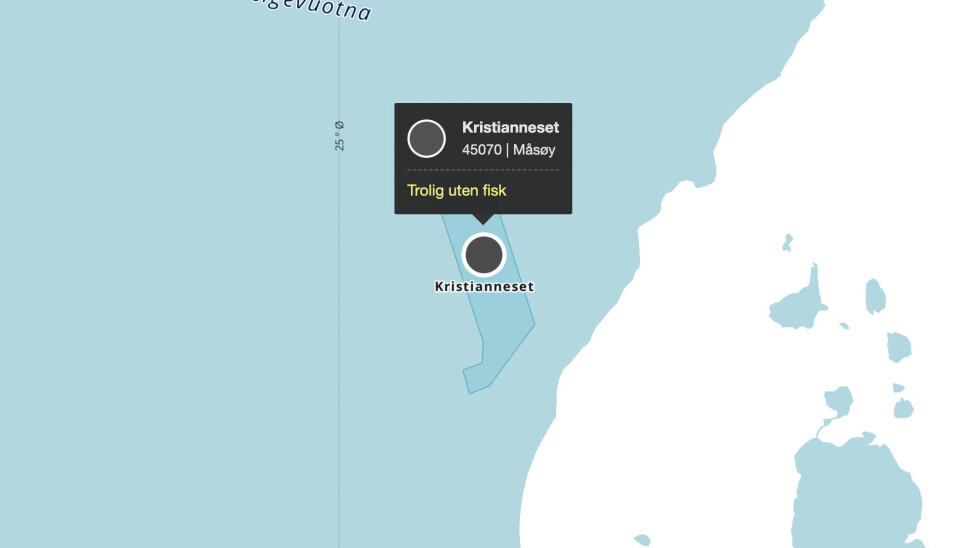
Cermaq had to cull 1.6 million smolts due to storms and Caligus
'We have never experienced such cases before,' says fish farmer
In September, the Norwegian Food Safety Authority (Mattilsynet) was notified about extremely high mortality due to bad weather at a site operated by Cermaq, the world's third-largest Atlantic salmon farmer. The mortality and injuries to fish at the Kristianneset site near Måsøy in Finnmark, northern Norway, were considered acute, and there was no suspicion of contagious disease. This led to an inspection by the Food Safety Authority, which encountered thousands of dead fish and floaters (moribund fish) at the site.
In a report accessed by Fish Farming Expert's Norwegian sister site, Kyst.no, the Food Safety Authority writes that during the inspection on September 27, there was still very high mortality in several cages.
"The floaters primarily had injuries or sores on their backs (seen as white spots to varying degrees along the entire back). At the same time, there were a lot of sea lice on the backs of the floaters (more than 20 sea lice on each fish). Some of the floaters also had sores over the head/head injuries. Some of the floaters were standing vertically in the cage," it is stated in the report.
When several hundred thousand salmon die in a week and the mortality at the site is increasing, we believe it constitutes a violation of regulations.
The report points out that there was high jumping activity in most of the cages.
During the inspection, the Food Safety Authority observed around 12,500 dead fish, distributed across the 10 cages at the site. The day before the inspection, approximately 20,000 dead fish were removed from cage 1. During the inspection, 23,561 dead fish were pulled from the dead fish scoop, which the Food Safety Authority describes as mainly fresh.
"Many had wounds on the gill covers of varying degrees, either on one side or both. In some dead fish, the gill cover was missing or there were wounds towards the eye/brain. Some of the dead fish had injuries/puncture wounds on the back. Most had severe scale loss. Some dead fish had bleeding under the belly or at the fin base of the ventral fins. Nearly all dissected fish had no food in the stomach/intestine. The appetite is described as poor in most cages, and best in cages 6, 7, and 8. Another round of dead fish removal was planned for the same day as the inspection."
The fish were stocked at the end of July, and until September 24, the mortality looked like this:
Cumulative mortality
| Pen 1 | 31% |
| Pens 2, 3 and 4 | 22% to 25% |
| Pen 5 | 51% |
| Pens 6, 7 and 8 | 17 - 18% |
| Pen 9 | 26% |
| Pen 10 | 39% |
Source: Mattilsynet
Food Safety Authority's assessment
The Norwegian Food Safety Authority refers to the Institute of Marine Research (IMR) as its knowledge support for fish welfare. IMR considers a mortality rate equal to or above 0.50% per week as very high. In week 38, the mortality at the site was over 10% in all cages.
"When several hundred thousand salmon die in a week and the mortality at the site is increasing, we believe it constitutes a violation of regulations," states the report from the Norwegian Food Safety Authority.
The measures implemented were to remove moribund and dead fish, an action that the authority points out did not help reduce mortality.

Never experienced before
Cermaq's regional director in Finnmark, Gunnar Bragi Gudmundsson, tells Kyst.no that a combination of severe weather, with strong winds and heavy waves, in addition to a drastic increase in sea lice (Caligus elongatus) led to many smolts suddenly dying at the site.
"These were smolts averaging about 200 grams and were without signs of disease when they were stocked in the summer. The poor combination of bad weather and sea lice led to significantly reduced welfare for the remaining fish at the site."
Gudmondsson explains that because of this, Cermaq decided to remove the remaining smolts. In total, the site had 1.6 million smolts.
"We have never experienced such cases before, as similar sites have had good results with smolt of the same size that also had extra deep nets. We will evaluate the course of events and routines to ensure further measures in the event of weather and lice impact to avoid similar situations in the future."
He adds that the company has suffered a financial loss due to the incident, but that the main focus is to ensure measures to avoid similar situations in the future.
"It is a very regrettable incident, but we believe we have implemented the correct measures given the challenging situation," concludes the regional director.



































































